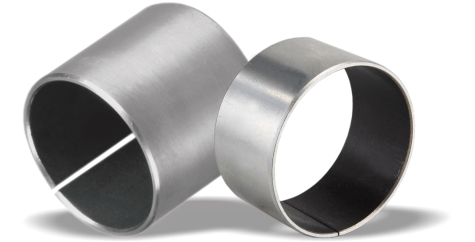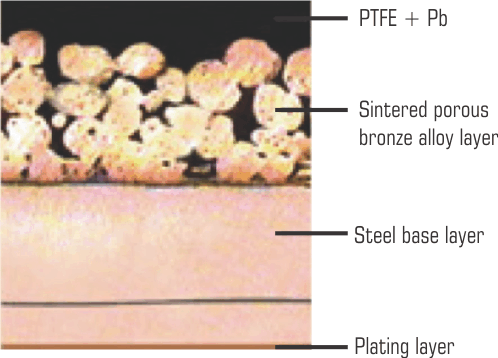|

Applications
* Toggle link bearings for injection machines
* Arm link bearings for power shovels
* Bearings for use in conditions of high load, low velocity and self-lub, such as dam gate and water gate bushings
* Bearings for underwater use like a guide vane bearings of turbine
* Bearings for use at a high temperature, including iron and manufacturing machineries
* Bearings for use in strong radioactive environment, e.g. Nuclear power plant
* Hydraulic steel structures
* Offshore industry *
Ship building * Power stations and reactors
* Iron and steel mills *
Heavy engineering * Mining nConstruction and earth moving machinery
* Crane and conveyor systems
* Civil engineering bridges pipelines etc.
* Where thermal expansion has to be absorbed.
Smooth, Oilless Operation
 The Dry Bushing (DU bushing) is the ultimate in oilless bearing design, using lead and tetrafluoroethylene (Teflon) having excellent wear resistance which optimizes metal properties such as strength and dimensional stability. The Dry Bushing (DU bushing) is the ultimate in oilless bearing design, using lead and tetrafluoroethylene (Teflon) having excellent wear resistance which optimizes metal properties such as strength and dimensional stability.
Coefficients of static and dynamic friction are so small that the bearing surfaces run smoothly without lubrication, while at the same time eliminating sticking and slipping. Unlike regular bearings which require constant lubrication, the MB type does away with the need for costly maintenance. It is also possible to combine them with parts totally submerged in a lubricant.
FEATURES
1. The bearing surfaces have such low coefficients of static and dynamic friction that they require no lubrication.
AKmet bushing can also be used in lubricants.
2. The operating temperature range extends from - 200ºC to 280ºC.
3. AKmet bushing operate smoothly under loads which exert high levels of resistance, impact, intermittent motion, and thrust.
4. AKmet bushing are free from electrostatic induction. When installed, each MB bearing has an electrical resistance of 1Ω to 10Ω per 1 cm 2 wide contact area.
5. AKmet bushing surface is highly resistant to most industrial chemicals and solvents including gas, oil, and alcohol.
6. The mating surface (mounting shaft) is wear resistant.
7. Service life is extended.
8. AKmet bushing are light and thin (up to 3 mm thick), requering little space and permit compact equipment design.
9. AKmet bushing minimize operating noise.
10. Standard Akmet bushings are available for quick delivery.Non-standard AKmet bushings can be made to order.

Physical and Mechanical Performance
Normally, the surface polymer of AKMET is of chemical-erosion resistant quality. However it can be eroded bv fused alkali metal and high temperature fluorine compounds. Therefore its erosion-prevention quality is primarily decided by the quality of the steel back and its plating layer. Air-erosion could be effectively prevented if the steel back is bronze or tin-plated. If the bush is to be used in corrosive environment, the steel back needs to be plated with lead, zinc, nickel or nickel-chrome alloy, etc.
Friction Characteristics
AKMET is of much lower friction coefficient. Friction coefficient may relatively become smaller under heavier load. When the load pressure is more than 7Mpa, its friction coefficient may reduce to 0.05 or smaller. In addition, friction coefficient will also become smaller with lower linear velocity and higher temperature.
Anti-abrasion Performance
AKMET is of excellent anti-abrasion performance, mainly due to die particular molecule structure of PTFE. The abrasion process can be generally divided into three phases, so there are three kinds of friction coefficient. See the right graph:
1. "Running-in" phrase: PTFE compound on the bush is transferred to its mating surface and forms a lubricating film. At this phase, the friction coefficient is bigger, thus the abrasion pace is very quick, See the curve showed in area I of the graph.
"Running-in" phrase: PTFE compound on the bush is transferred to its mating surface and forms a lubricating film. At this phase, the friction coefficient is bigger, thus the abrasion pace is very quick, See the curve showed in area I of the graph.
2. 'Stabilization* abrasion phrase: After the 'Running-in phase', the friction liappens between PTFE and PTFE, thus the friction coefficient is smaller and keeps steady. As a result, the wear rate is low and steady, bee the curve showed in area II of the graph.
3. "Slurp" abrasion phrase: As PTFE in the porous layer is slowly consumed up, not enough lubricant can be supplied to the gliding media. Friction coefficient .UK! wear rate will rapidly rise. When 70% uf the bronze surface is exposed, service life of AKMET closes to its end. See the curve showed in area III of the graph.
The Advantages of Self-Lubricating Bushings
• Elimination Of Oil Holes And Grooves - Cost for machining oil holes and oil grooves is unnecessary. Self-lubricating eliminates the need for the extra oiling system.
• Reduction Of The Machinery Running Cost - With maintenance free features, the lubricant oil is dramatically reduced; machinery running cost will also be decreased.
• Maintenance Free Operation - Self-lubricating bushings solve the problem of oiling operation and oiling devices, also saving bearing maintenance costs.
• Simplified Mechanical Design And Manufacture - With above advantages, thin wall thickness, higher load, and excellent wear resistance, mechanical designs can be simplified and made more economical.
• The Environment Is Protected - The self-lubricating bearing materials work without oil and meet the ROHS directive.
|



 The Dry Bushing (DU bushing) is the ultimate in oilless bearing design, using lead and tetrafluoroethylene (Teflon) having excellent wear resistance which optimizes metal properties such as strength and dimensional stability.
The Dry Bushing (DU bushing) is the ultimate in oilless bearing design, using lead and tetrafluoroethylene (Teflon) having excellent wear resistance which optimizes metal properties such as strength and dimensional stability.
